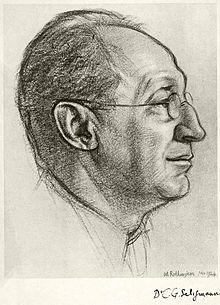C. G. Seligman
| Charles Gabriel Seligman | |
|---|---|
 |
|
| Born | 24 December 1873 London, England |
| Died | 19 September 1940 Oxford, England |
| Citizenship | British |
| Fields | Anthropology, history |
| Alma mater | St Thomas' Hospital |
| Known for | Races of Africa (1930) |
| Influenced |
Bronisław Malinowski E. E. Evans-Pritchard Meyer Fortes |
Charles Gabriel Seligman FRS (24 December 1873 – 19 September 1940) was a British physician and ethnologist. His main ethnographic work described the culture of the Vedda people of Sri Lanka and the Shilluk people of the Sudan. He was a Professor at London School of Economics and was highly influential as the teacher of such notable anthropologists as Bronisław Malinowski, E. E. Evans-Pritchard and Meyer Fortes all of whose work overshadowed his own. He was a proponent of the Hamitic hypothesis, according to which, some civilizations of Africa were thought to have been founded by Caucasoid Hamitic peoples.
Born in London, Seligman studied medicine at St Thomas' Hospital. After several years as a physician and pathologist, he volunteered his services to the 1898 Cambridge University expedition to the Torres Strait. He later joined expeditions to New Guinea (1904), Ceylon (1906-1908), and Sudan (1909-1912, again in 1921-1922).
In 1905, Seligman married Brenda Zara Salaman, who accompanied him on many of his expeditions and who he credited in his publications.
From 1913 to 1934, he served as chair of Ethnology at the London School of Economics, where the Anthropology department maintains the Seligman Library in his name.
Seligman was also a Fellow of the Royal Society.
...
Wikipedia
